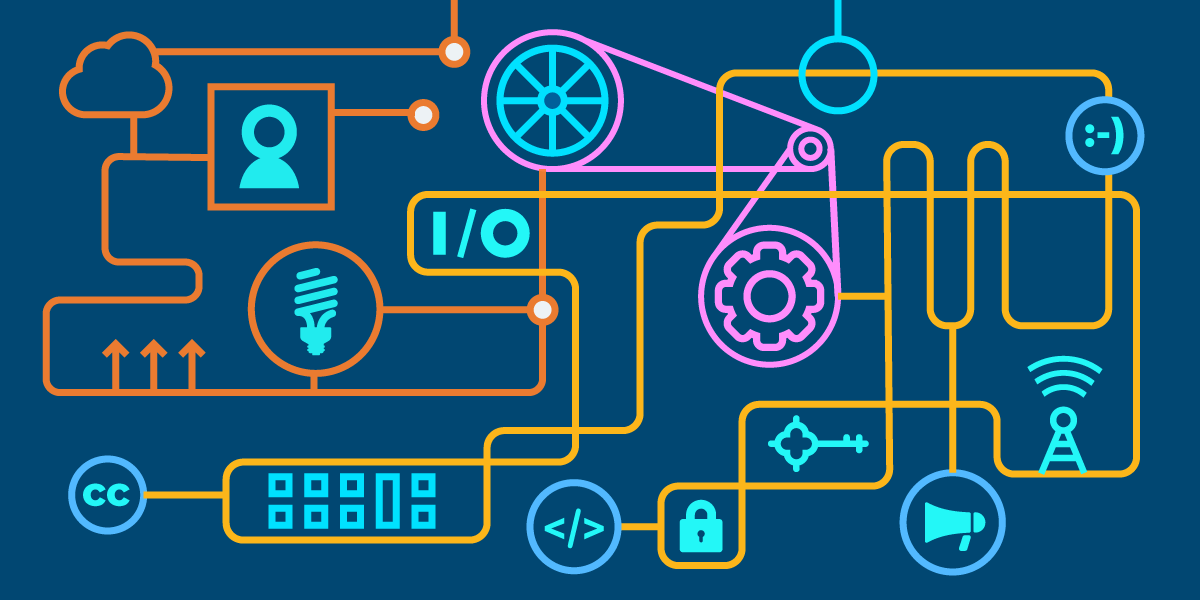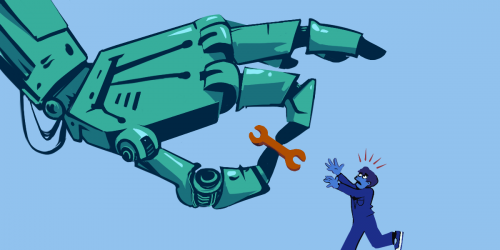Today, we are told that the bigness of Big Tech giants was inevitable: the result of "network effects." For example, once everyone you want to talk to is on Facebook, you can't be convinced to use another, superior service, because all the people you'd use that service to talk to are still on Facebook. And of course, those people also can't leave Facebook, because you're still there.
But network effects were once a double-edge sword, one that could be wielded both by yesterday's Goliaths and today's Davids. Once, network effects made companies vulnerable, just as much as they protected them.
The early, pre-graphic days of the Internet were dominated by Usenet, a decentralized, topic-based discussion-board system that ran on UUCP -- AT&T's Unix-to-Unix Copy utility -- that allowed administrators of corporate servers to arrange for their computers to dial into other organizations' computers and exchange stored messages with them, and to pass on messages that were destined for more distant systems. Though UUCP was originally designed for person-to-person messaging and limited file transfers, the administrators of the world's largest computer systems wanted a more freewheeling, sociable system, and so Usenet was born.
Usenet systems dialed each other up to exchange messages, using slow modems and commercial phone lines. Even with the clever distribution system built into Usenet (which allowed for one node to receive long-distance messages for its closest neighbors and then pass the messages on at local calling rates), and even with careful call scheduling to chase the lowest long-distance rates in the dead of night, Usenet was still responsible for racking up some prodigious phone bills for the corporations who were (mostly unwittingly) hosting it.
The very largest Usenet nodes were hosted by companies so big that their Usenet-related long distance charges were lost in the dictionary-sized bills the company generated every month (some key nodes were operated by network administrators who worked for phone companies where long-distance calls were free).
The administrators of these key nodes semi-jokingly called themselves "the backbone cabal" and they saw themselves as having a kind of civic duty to Usenet, part of which was ensuring that their bosses never got wind of it and (especially) that Usenet never created the kind of scandal that would lead to public outcry that would threaten the project.
Which is why the backbone cabal was adamant that certain discussion forums be suppressed. Thanks to a convention proposed by EFF co-founder John Gilmore, there was a formal process for creating a Usenet newsgroup, requiring that a certain number of positive votes be cast for the group's creation by Usenet's users, and that this positive force not be checked by too many negative votes. Though this compromise stacked the deck against controversy by allowing a critical mass of objectors to block even very popular proposals, some proposed controversial newsgroups made it through the vote.
When that happened, the backbone cabal response was to "protect Usenet from its own users," by refusing to carry these controversial newsgroups on their long-haul lines, meaning that all the local systems (who depended on on the backbone to serve up UUCP feeds without long-distance fees) would not be able to see them. It was a kind of network administrator's veto.
Usenet users chafed at the veto. Some of the "controversial" subjects the cabal blocked (like recreational drugs) were perfectly legitimate subjects of inquiry; in other cases (rec.gourmand -- a proposal for a group about cooking inside the "recreation" category, rather than the "talk" category), the cabal's decision was hard to see as anything but capricious and arbitrary.
In response, John Gilmore, Gordon Moffett and Brian Reid created a new top-level category in the Usenet hierarchy: alt., and in 1987, the first alt. newsgroup was formed: alt.gourmand.
The backbone did not carry the alt. hierarchy, but that wasn't the end of things. Gilmore was willing to subsidize the distribution of the alt. hierarchy, and he let it be known that he would pay the long distance charges to have his UUCP server dial up to distant systems and give them an alt. feed. Because UUCP allowed for the consolidation of feeds from multiple sources, Usenet users could get their regular Usenet feeds from the backbone cabal, and their alt. feeds from Gilmore; as time went by and new services like Telenet provided new ways of bridging systems that were cheaper than long-distance modem calls, and as the modems themselves got faster, and an Internet protocol for Usenet messages called NNTP was created and the alt. hierarchy became the most popular part of Usenet.
The crisis that the backbone cabal had feared never materialized. The alt. hierarchy's freewheeling rules -- that let anyone add any newsgroup without permission from third parties -- came to dominate the Internet, from the Web (anyone can add a website) to its many services (anyone can add a hashtag or create a social media group).
The story of the alt. hierarchy is an important lesson about the nearly forgotten art of "adversarial interoperability," in which new services can be plugged into existing ones, without permission or cooperation from the operators of the dominant service.
Today, we're told that Facebook will dominate forever because everyone you want to talk to is already there. But that was true of the backbone cabal's alt.-free version of Usenet, which controlled approximately one hundred percent of the socializing on the nascent Internet. Luckily, the alt. hierarchy was created before Facebook distorted the Computer Fraud and Abuse Act to try to criminalize terms of service violations. Usenet had no terms of service and no contracts. There were only community standards and mores, endlessly discussed. It was created in an era when software patents were rare and narrow, before the US Patent and Trademark Office started allowing patents on anything so long as you put "with a computer" in the application – a few years later, and Usenet creators might have tried to use Duke University and UNC’s patent portfolio to try to shut down anyone who plugged something as weird, dangerous and amazing as alt. into the Usenet (wags insisted that alt. didn't stand for "alternative," but rather, "Anarchists, Lunatics, and Terrorists"). As alt. grew, its spread demanded that Usenet's software be re-implemented for non-Unix computers, which was possible because software interfaces were not understood to be copyrightable – but today, Oracle is seeking to have the courts seal off that escape hatch for adversarial interoperability.
Deprived of these shields against adversarial interoperability, Usenet's network effects were used against it. Despite being dominated by the backbone cabal, Usenet had everything the alt. hierarchy needed to thrive: the world's total population of people interested in using the Internet to socialize; that meant that the creators of alt. could invite all Usenet users and to expand their reading beyond the groups that met with the cabal's approval without having to get the cabal's permission. Thanks to the underlying design of Usenet, the new alt. groups and the incumbent Usenet newsgroups could be seamlessly merged into a system that acted like a single service for its users.
If adversarial interoperability still enjoyed its alt.-era legal respectability, then Facebook alternatives like Diaspora could use their users' logins and passwords to fetch the Facebook messages the service had queued up for them and allow those users to reply to them from Diaspora, without being spied on by Facebook. Mastodon users could read and post to Twitter without touching Twitter's servers. Hundreds or thousands of services could spring up that allowed users different options to block harassment and bubble up interesting contributions from other users -- both those on the incumbent social media services, and the users of these new upstarts. It's true that unlike Usenet, Facebook and Twitter have taken steps to block this kind of federation, so perhaps the experience won't be as seamless as it was for alt. users mixing their feeds in with the backbone's feeds, but the main hurdle – moving to a new service without having to convince everyone to come with you – could be vanquished.
In the absence of adversarial interoperability, we're left trying to solve the impossible collective action problem of getting everyone to switch at once, or to maintain many different accounts that reach many different groups of potential users.
Regulators are increasingly bullish on interoperability and have made noises about creating standards that let one service plug into another one. But as important as these standards are, they should be the floor on interoperability, not the ceiling. Standards created with input from the tech giants will always have limits designed to protect them from being disrupted out of existence, the way they disrupted the market leaders when they were pipsqueak upstarts.
Restoring adversarial interoperability will allow future companies, co-operatives and tinkerers to go beyond the comfort zones of the winners of the previous rounds of the game -- so that it ceases to be a winner-take-all affair, and instead becomes the kind of dynamic place where a backbone cabal can have total control one year, and be sidelined the next.









